Abstract
A concept of olfactory coding is proposed. It describes the stimulus responses of all receptor cells by the use of vector spaces. The morphological convergence pattern between receptor cells and glomeruli is given in the same vector space as the receptor cell activities. The overall input of a glomerulus follows as the scalar product of the receptor cell activity vector and the vector of the glomerulus' convergence pattern. The proposed coding concept shows how the network of the olfactory bulb succeeds in discriminating odors with high selectivity. It is concluded that sets of mitral cells coding similar odors work very much in the way of mutually inhibited matched filters. This solves one main problem both in olfaction as well as real-time odor detection by an artificial nose, i.e., how the fairly low degree of selectivity of receptor cells or sensors is overcome by the neural network following the receptor stage. The formal description of olfactory coding suggests that quality perception which is invariant under concentration shifts is accomplished by an associative memory in the olfactory bulb.
Full text
PDF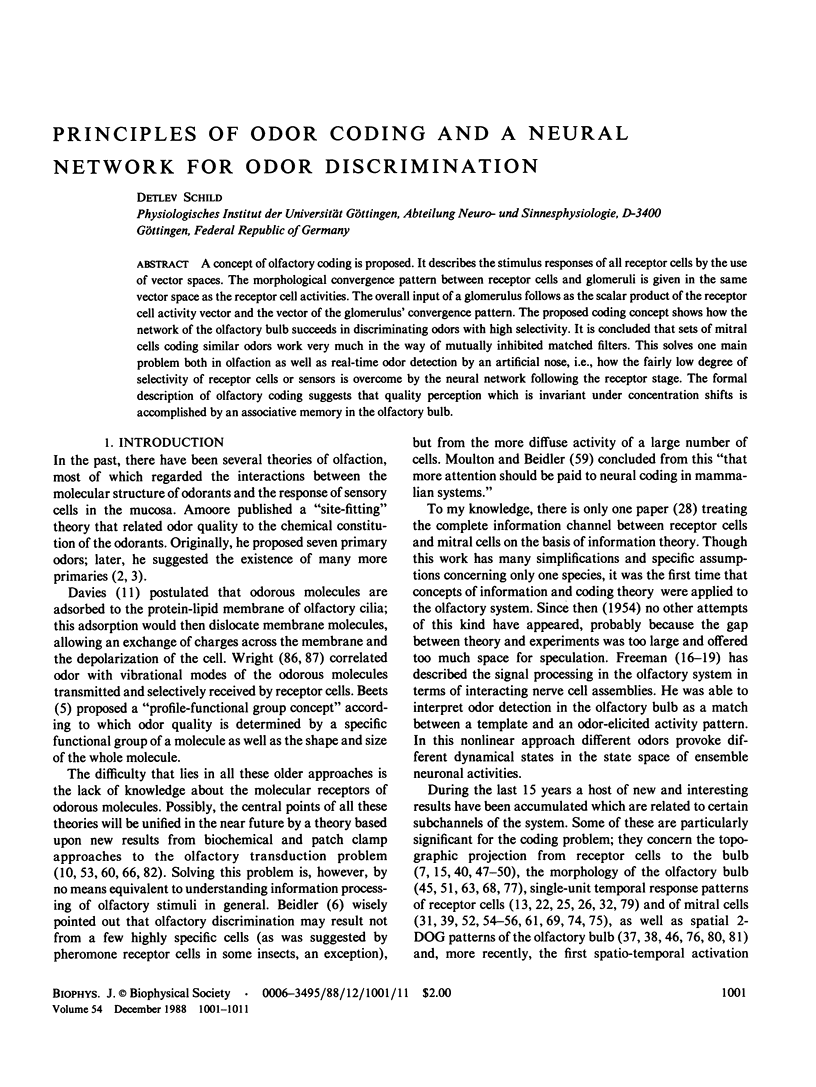
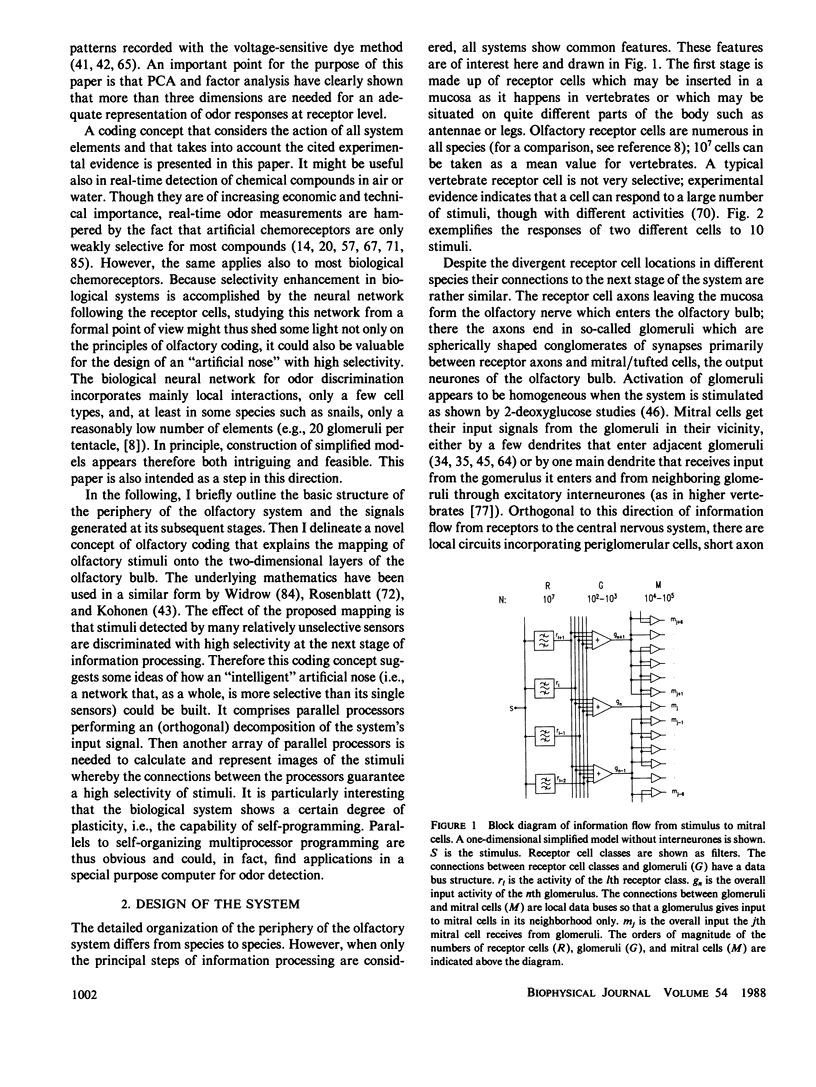
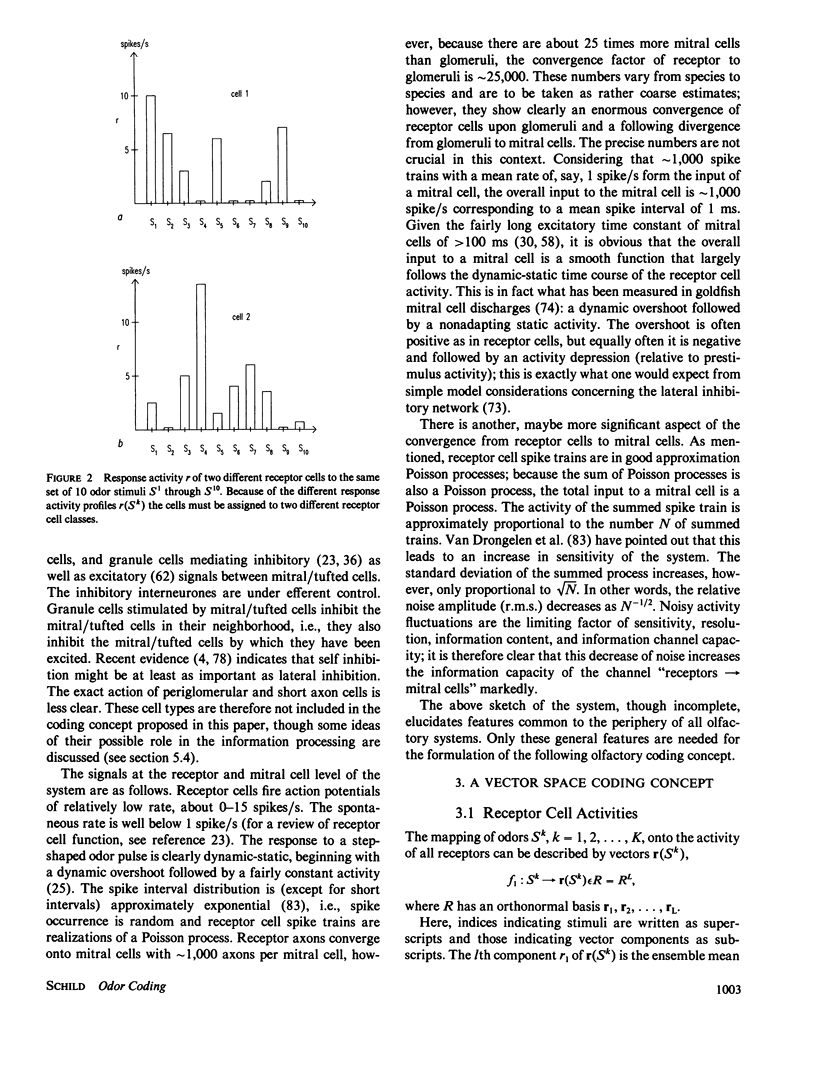

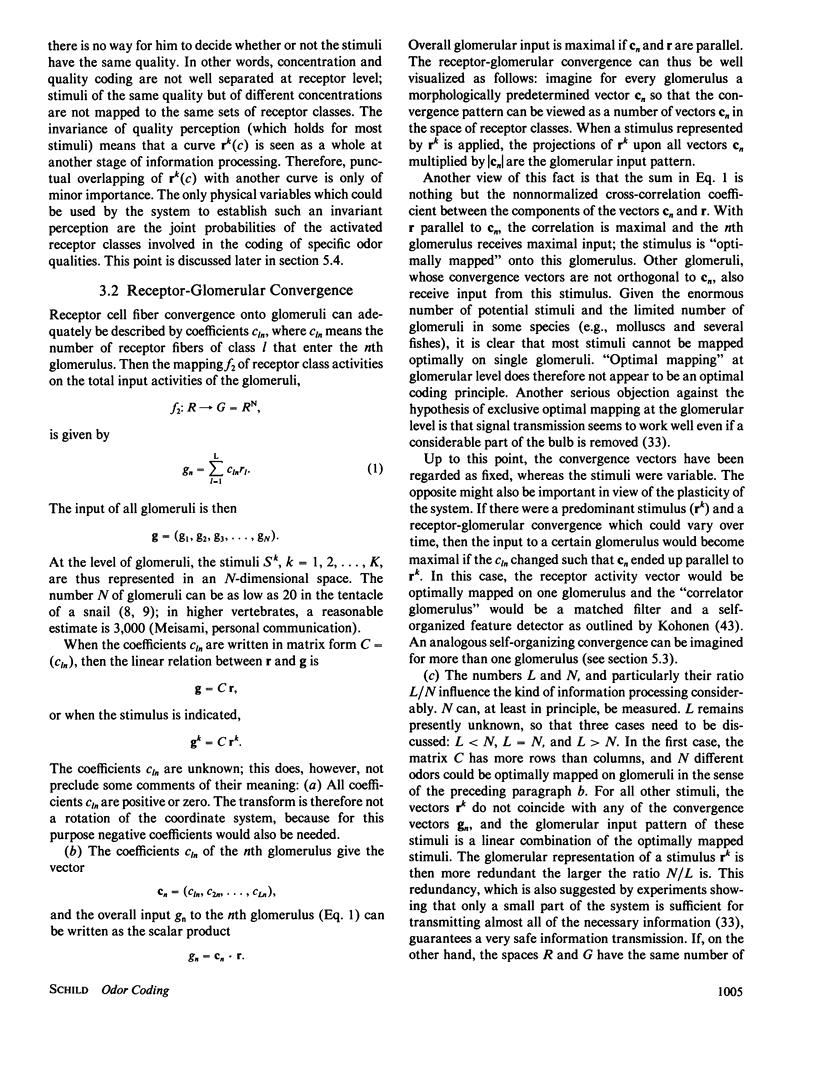

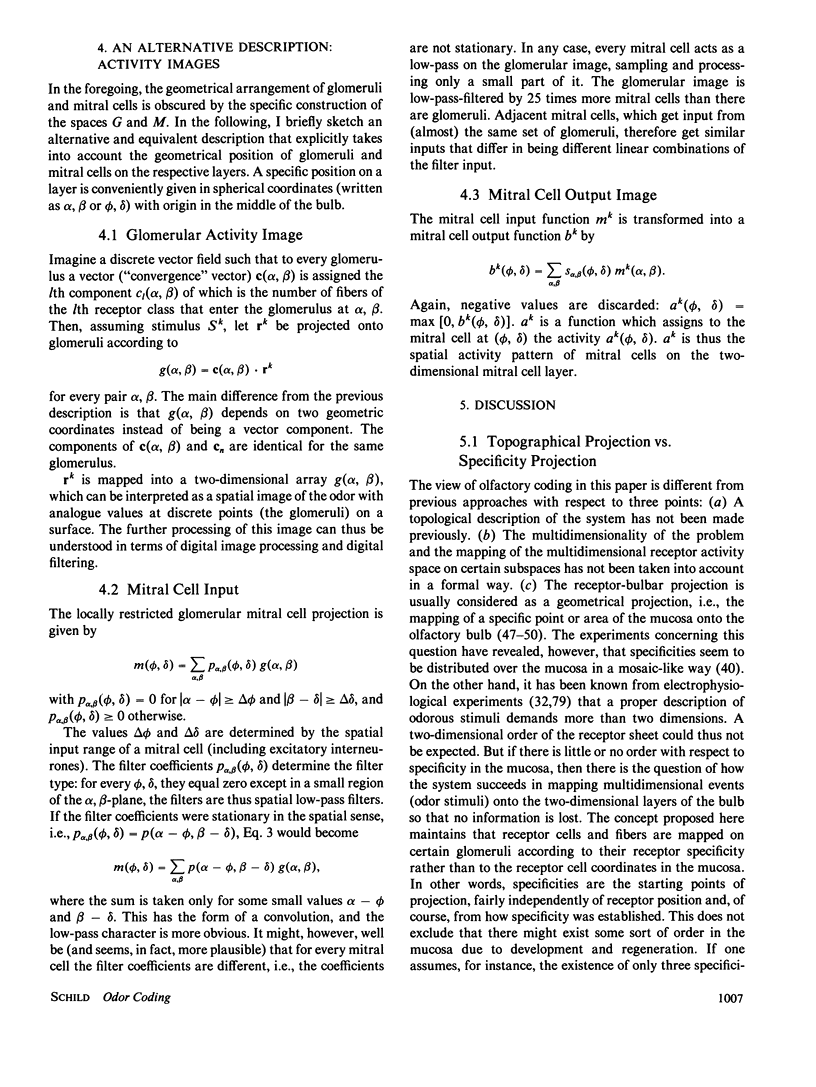
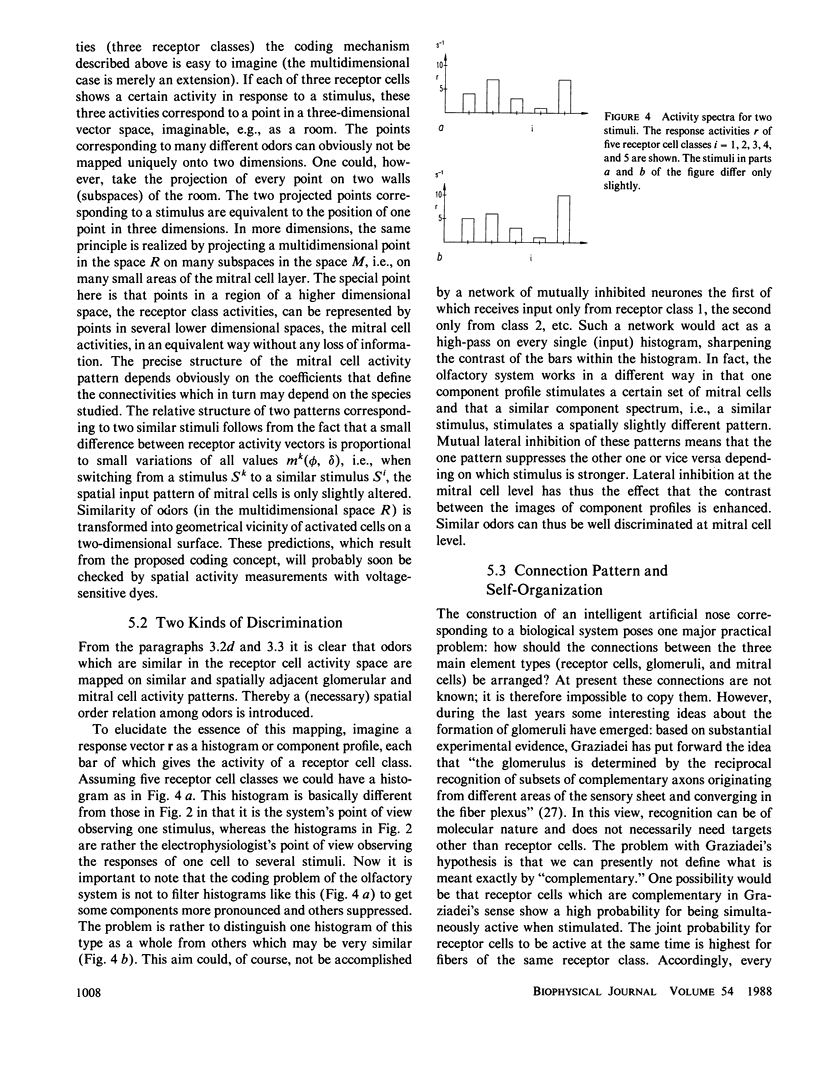
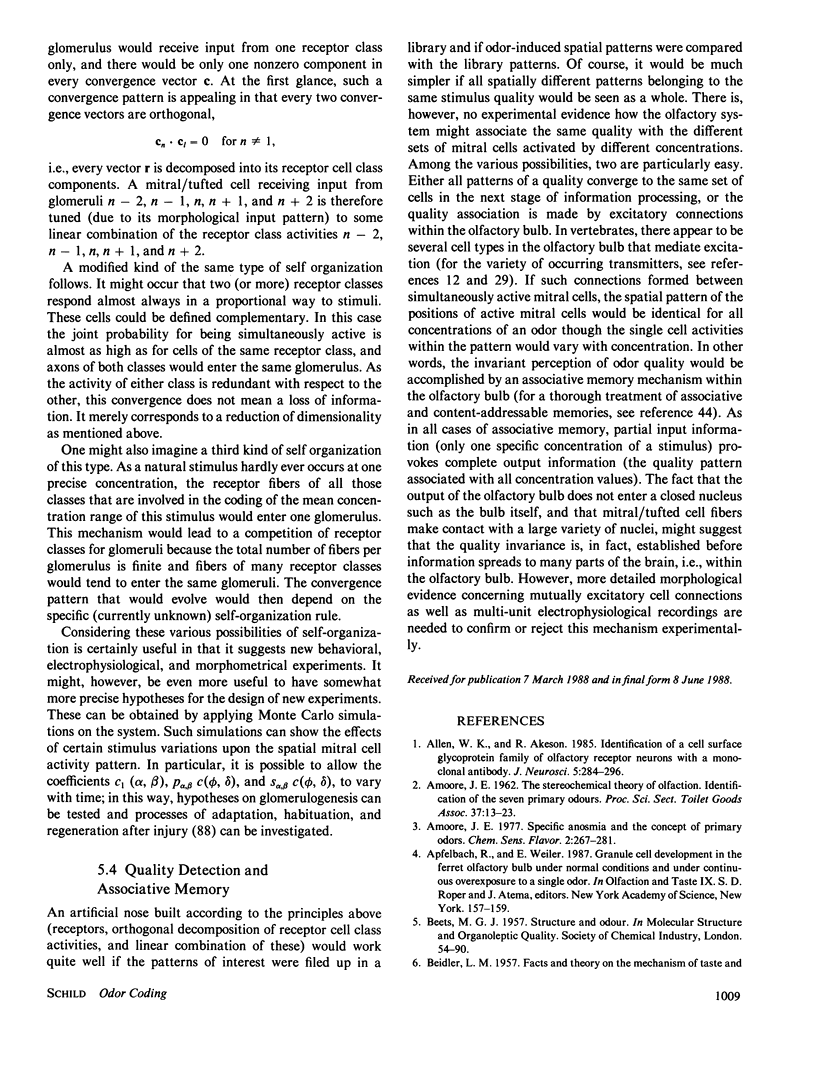
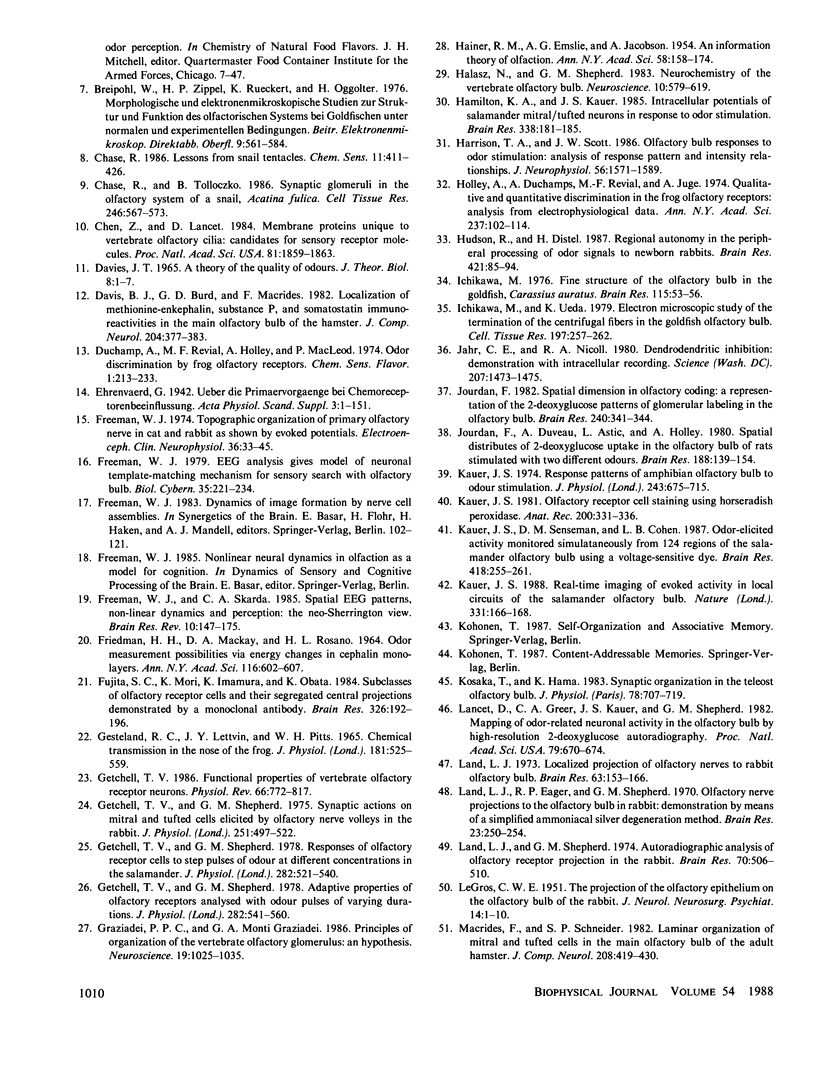
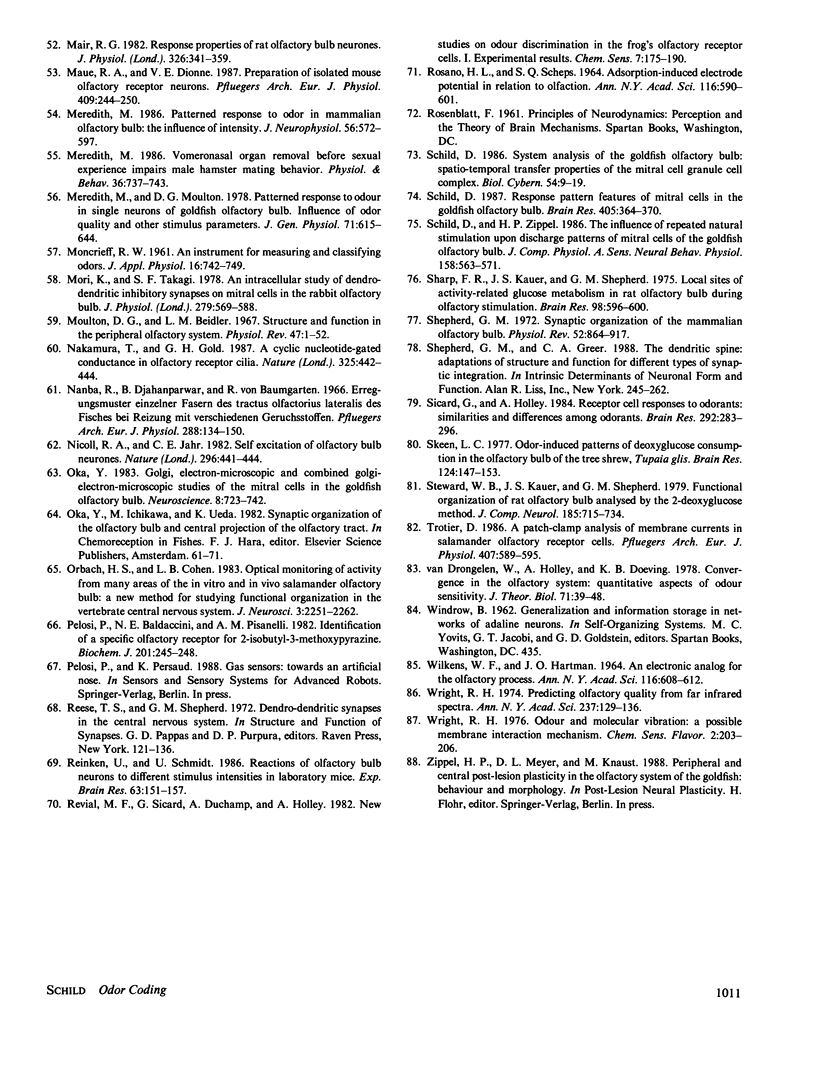
Selected References
These references are in PubMed. This may not be the complete list of references from this article.
- Allen W. K., Akeson R. Identification of a cell surface glycoprotein family of olfactory receptor neurons with a monoclonal antibody. J Neurosci. 1985 Feb;5(2):284–296. doi: 10.1523/JNEUROSCI.05-02-00284.1985. [DOI] [PMC free article] [PubMed] [Google Scholar]
- CLARK W. E. le G. The projection of the olfactory epithelium on the olfactory bulb in the rabbit. J Neurol Neurosurg Psychiatry. 1951 Feb;14(1):1–10. doi: 10.1136/jnnp.14.1.1. [DOI] [PMC free article] [PubMed] [Google Scholar]
- Chen Z., Lancet D. Membrane proteins unique to vertebrate olfactory cilia: candidates for sensory receptor molecules. Proc Natl Acad Sci U S A. 1984 Mar;81(6):1859–1863. doi: 10.1073/pnas.81.6.1859. [DOI] [PMC free article] [PubMed] [Google Scholar]
- Davies J. T. A theory of the quality of odours. J Theor Biol. 1965 Jan;8(1):1–7. doi: 10.1016/0022-5193(65)90086-x. [DOI] [PubMed] [Google Scholar]
- Davis B. J., Burd G. D., Macrides F. Localization of methionine-enkephalin, substance P, and somatostatin immunoreactivities in the main olfactory bulb of the hamster. J Comp Neurol. 1982 Feb 1;204(4):377–383. doi: 10.1002/cne.902040408. [DOI] [PubMed] [Google Scholar]
- FRIEDMAN H. H., MACKAY D. A., ROSANO H. L. ODOR MEASUREMENT POSSIBILITIES VIA ENERGY CHANGES IN CEPHALIN MONOLAYERS. Ann N Y Acad Sci. 1964 Jul 30;116:602–607. doi: 10.1111/j.1749-6632.1964.tb45091.x. [DOI] [PubMed] [Google Scholar]
- Freeman W. J. EEG analysis gives model of neuronal template-matching mechanism for sensory search with olfactory bulb. Biol Cybern. 1979 Dec;35(4):221–234. doi: 10.1007/BF00344205. [DOI] [PubMed] [Google Scholar]
- Freeman W. J., Skarda C. A. Spatial EEG patterns, non-linear dynamics and perception: the neo-Sherringtonian view. Brain Res. 1985 Dec;357(3):147–175. doi: 10.1016/0165-0173(85)90022-0. [DOI] [PubMed] [Google Scholar]
- Freeman W. J. Topographic organization of primary olfactory nerve in cat and rabbit as shown by evoked potentials. Electroencephalogr Clin Neurophysiol. 1974 Jan;36(1):33–45. doi: 10.1016/0013-4694(74)90134-5. [DOI] [PubMed] [Google Scholar]
- Fujita S. C., Mori K., Imamura K., Obata K. Subclasses of olfactory receptor cells and their segregated central projections demonstrated by a monoclonal antibody. Brain Res. 1985 Feb 4;326(1):192–196. doi: 10.1016/0006-8993(85)91403-9. [DOI] [PubMed] [Google Scholar]
- Gesteland R. C., Lettvin J. Y., Pitts W. H. Chemical transmission in the nose of the frog. J Physiol. 1965 Dec;181(3):525–559. doi: 10.1113/jphysiol.1965.sp007781. [DOI] [PMC free article] [PubMed] [Google Scholar]
- Getchell T. V. Functional properties of vertebrate olfactory receptor neurons. Physiol Rev. 1986 Jul;66(3):772–818. doi: 10.1152/physrev.1986.66.3.772. [DOI] [PubMed] [Google Scholar]
- Getchell T. V., Shepherd G. M. Adaptive properties of olfactory receptors analysed with odour pulses of varying durations. J Physiol. 1978 Sep;282:541–560. doi: 10.1113/jphysiol.1978.sp012480. [DOI] [PMC free article] [PubMed] [Google Scholar]
- Getchell T. V., Shepherd G. M. Responses of olfactory receptor cells to step pulses of odour at different concentrations in the salamander. J Physiol. 1978 Sep;282:521–540. doi: 10.1113/jphysiol.1978.sp012479. [DOI] [PMC free article] [PubMed] [Google Scholar]
- Getchell T. V., Shepherd G. M. Synaptic actions on mitral and tufted cells elicited by olfactory nerve volleys in the rabbit. J Physiol. 1975 Oct;251(2):497–522. doi: 10.1113/jphysiol.1975.sp011105. [DOI] [PMC free article] [PubMed] [Google Scholar]
- Graziadei P. P., Monti Graziadei G. A. Principles of organization of the vertebrate olfactory glomerulus: an hypothesis. Neuroscience. 1986 Dec;19(4):1025–1035. doi: 10.1016/0306-4522(86)90119-3. [DOI] [PubMed] [Google Scholar]
- HAINER R. M., EMSLIE A. G., JACOBSON A. An information theory of olfaction. Ann N Y Acad Sci. 1954 Mar 24;58(2):158–174. doi: 10.1111/j.1749-6632.1954.tb54851.x. [DOI] [PubMed] [Google Scholar]
- Halász N., Shepherd G. M. Neurochemistry of the vertebrate olfactory bulb. Neuroscience. 1983 Nov;10(3):579–619. doi: 10.1016/0306-4522(83)90206-3. [DOI] [PubMed] [Google Scholar]
- Hamilton K. A., Kauer J. S. Intracellular potentials of salamander mitral/tufted neurons in response to odor stimulation. Brain Res. 1985 Jul 8;338(1):181–185. doi: 10.1016/0006-8993(85)90265-3. [DOI] [PubMed] [Google Scholar]
- Harrison T. A., Scott J. W. Olfactory bulb responses to odor stimulation: analysis of response pattern and intensity relationships. J Neurophysiol. 1986 Dec;56(6):1571–1589. doi: 10.1152/jn.1986.56.6.1571. [DOI] [PubMed] [Google Scholar]
- Holley A., Duchamp A., Revial M. F., Juge A. Qualitative and quantitative discrimination in the frog olfactory receptors: analysis from electrophysiological data. Ann N Y Acad Sci. 1974 Sep 27;237(0):102–114. doi: 10.1111/j.1749-6632.1974.tb49847.x. [DOI] [PubMed] [Google Scholar]
- Hudson R., Distel H. Regional autonomy in the peripheral processing of odor signals in newborn rabbits. Brain Res. 1987 Sep 22;421(1-2):85–94. doi: 10.1016/0006-8993(87)91278-9. [DOI] [PubMed] [Google Scholar]
- Ichikawa M., Ueda K. Electron microscopic study of the termination of the centrifugal fibers in the goldfish olfactory bulb. Cell Tissue Res. 1979 Mar 19;197(2):257–262. doi: 10.1007/BF00233918. [DOI] [PubMed] [Google Scholar]
- Jahr C. E., Nicoll R. A. Dendrodendritic inhibition: demonstration with intracellular recording. Science. 1980 Mar 28;207(4438):1473–1475. doi: 10.1126/science.7361098. [DOI] [PubMed] [Google Scholar]
- Jourdan F., Duveau A., Astic L., Holley A. Spatial distribution of [14C]2-deoxyglucose uptake in the olfactory bulbs of rats stimulated with two different odours. Brain Res. 1980 Apr 21;188(1):139–154. doi: 10.1016/0006-8993(80)90563-6. [DOI] [PubMed] [Google Scholar]
- Jourdan F. Spatial dimension in olfactory coding: a representation of the 2-deoxyglucose patterns of glomerular labeling in the olfactory bulb. Brain Res. 1982 May 27;240(2):341–344. doi: 10.1016/0006-8993(82)90232-3. [DOI] [PubMed] [Google Scholar]
- Kauer J. S. Olfactory receptor cell staining using horseradish peroxidase. Anat Rec. 1981 Jul;200(3):331–336. doi: 10.1002/ar.1092000313. [DOI] [PubMed] [Google Scholar]
- Kauer J. S. Real-time imaging of evoked activity in local circuits of the salamander olfactory bulb. Nature. 1988 Jan 14;331(6152):166–168. doi: 10.1038/331166a0. [DOI] [PubMed] [Google Scholar]
- Kauer J. S. Response patterns of amphibian olfactory bulb neurones to odour stimulation. J Physiol. 1974 Dec;243(3):695–715. doi: 10.1113/jphysiol.1974.sp010772. [DOI] [PMC free article] [PubMed] [Google Scholar]
- Kauer J. S., Senseman D. M., Cohen L. B. Odor-elicited activity monitored simultaneously from 124 regions of the salamander olfactory bulb using a voltage-sensitive dye. Brain Res. 1987 Aug 25;418(2):255–261. doi: 10.1016/0006-8993(87)90093-x. [DOI] [PubMed] [Google Scholar]
- Kosaka T., Hama K. Synaptic organization in the teleost olfactory bulb. J Physiol (Paris) 1982;78(8):707–719. [PubMed] [Google Scholar]
- Lancet D., Greer C. A., Kauer J. S., Shepherd G. M. Mapping of odor-related neuronal activity in the olfactory bulb by high-resolution 2-deoxyglucose autoradiography. Proc Natl Acad Sci U S A. 1982 Jan;79(2):670–674. doi: 10.1073/pnas.79.2.670. [DOI] [PMC free article] [PubMed] [Google Scholar]
- Land L. J., Eager R. P., Shepherd G. M. Olfactory nerve projections to the olfactory bulb in rabbit: demonstration by means of a simplified ammoniacal silver degeneration method. Brain Res. 1970 Oct 13;23(2):250–254. doi: 10.1016/0006-8993(70)90044-2. [DOI] [PubMed] [Google Scholar]
- Land L. J. Localized projection of olfactory nerves to rabbit olfactory bulb. Brain Res. 1973 Dec 7;63:153–166. doi: 10.1016/0006-8993(73)90084-x. [DOI] [PubMed] [Google Scholar]
- Land L. J., Shepherd G. M. Autoradiographic analysis of olfactory receptor projections in the rabbit. Brain Res. 1974 Apr 26;70(3):506–510. doi: 10.1016/0006-8993(74)90259-5. [DOI] [PubMed] [Google Scholar]
- MONCRIEFF R. W. An instrument for measuring and classifying odors. J Appl Physiol. 1961 Jul;16:742–749. doi: 10.1152/jappl.1961.16.4.742. [DOI] [PubMed] [Google Scholar]
- Macrides F., Schneider S. P. Laminar organization of mitral and tufted cells in the main olfactory bulb of the adult hamster. J Comp Neurol. 1982 Jul 10;208(4):419–430. doi: 10.1002/cne.902080410. [DOI] [PubMed] [Google Scholar]
- Mair R. G. Response properties of rat olfactory bulb neurones. J Physiol. 1982 May;326:341–359. doi: 10.1113/jphysiol.1982.sp014197. [DOI] [PMC free article] [PubMed] [Google Scholar]
- Maue R. A., Dionne V. E. Preparation of isolated mouse olfactory receptor neurons. Pflugers Arch. 1987 Jul;409(3):244–250. doi: 10.1007/BF00583472. [DOI] [PubMed] [Google Scholar]
- Meredith M., Moulton D. G. Patterned response to odor in single neurones of goldfish olfactory bulb: influence of odor quality and other stimulus parameters. J Gen Physiol. 1978 Jun;71(6):615–643. doi: 10.1085/jgp.71.6.615. [DOI] [PMC free article] [PubMed] [Google Scholar]
- Meredith M. Patterned response to odor in mammalian olfactory bulb: the influence of intensity. J Neurophysiol. 1986 Sep;56(3):572–597. doi: 10.1152/jn.1986.56.3.572. [DOI] [PubMed] [Google Scholar]
- Meredith M. Vomeronasal organ removal before sexual experience impairs male hamster mating behavior. Physiol Behav. 1986;36(4):737–743. doi: 10.1016/0031-9384(86)90362-8. [DOI] [PubMed] [Google Scholar]
- Mori K., Takagi S. F. An intracellular study of dendrodendritic inhibitory synapses on mitral cells in the rabbit olfactory bulb. J Physiol. 1978 Jun;279:569–588. doi: 10.1113/jphysiol.1978.sp012362. [DOI] [PMC free article] [PubMed] [Google Scholar]
- Moulton D. G., Beidler L. M. Structure and function in the peripheral olfactory system. Physiol Rev. 1967 Jan;47(1):1–52. doi: 10.1152/physrev.1967.47.1.1. [DOI] [PubMed] [Google Scholar]
- Nakamura T., Gold G. H. A cyclic nucleotide-gated conductance in olfactory receptor cilia. 1987 Jan 29-Feb 4Nature. 325(6103):442–444. doi: 10.1038/325442a0. [DOI] [PubMed] [Google Scholar]
- Nanba R., Djahanparwar B., v Baumgarten R. Erregungsmuster einzelner Fasern des Tractus olfactorius lateralis des Fisches bei Reizung mit verschiedenen Geruchsstoffen. Pflugers Arch Gesamte Physiol Menschen Tiere. 1966;288(2):134–150. doi: 10.1007/BF00362564. [DOI] [PubMed] [Google Scholar]
- Nicoll R. A., Jahr C. E. Self-excitation of olfactory bulb neurones. Nature. 1982 Apr 1;296(5856):441–444. doi: 10.1038/296441a0. [DOI] [PubMed] [Google Scholar]
- Oka Y. Golgi, electron-microscopic and combined Golgi-electron-microscopic studies of the mitral cells in the goldfish olfactory bulb. Neuroscience. 1983 Apr;8(4):723–742. doi: 10.1016/0306-4522(83)90006-4. [DOI] [PubMed] [Google Scholar]
- Orbach H. S., Cohen L. B. Optical monitoring of activity from many areas of the in vitro and in vivo salamander olfactory bulb: a new method for studying functional organization in the vertebrate central nervous system. J Neurosci. 1983 Nov;3(11):2251–2262. doi: 10.1523/JNEUROSCI.03-11-02251.1983. [DOI] [PMC free article] [PubMed] [Google Scholar]
- Pelosi P., Baldaccini N. E., Pisanelli A. M. Identification of a specific olfactory receptor for 2-isobutyl-3-methoxypyrazine. Biochem J. 1982 Jan 1;201(1):245–248. doi: 10.1042/bj2010245. [DOI] [PMC free article] [PubMed] [Google Scholar]
- ROSANO H. L., SCHEPS S. Q. ADSORPTION-INDUCED ELECTRODE POTENTIAL IN RELATION TO OLFACTION. Ann N Y Acad Sci. 1964 Jul 30;116:590–601. doi: 10.1111/j.1749-6632.1964.tb45090.x. [DOI] [PubMed] [Google Scholar]
- Reinken U., Schmidt U. Reactions of olfactory bulb neurons to different stimulus intensities in laboratory mice. Exp Brain Res. 1986;63(1):151–157. doi: 10.1007/BF00235657. [DOI] [PubMed] [Google Scholar]
- Schild D. Response pattern features of mitral cells in the goldfish olfactory bulb. Brain Res. 1987 Mar 10;405(2):364–370. doi: 10.1016/0006-8993(87)90307-6. [DOI] [PubMed] [Google Scholar]
- Sharp F. R., Kauer J. S., Shepherd G. M. Local sites of activity-related glucose metabolism in rat olfactory bulb during olfactory stimulation. Brain Res. 1975 Nov 21;98(3):596–600. doi: 10.1016/0006-8993(75)90377-7. [DOI] [PubMed] [Google Scholar]
- Shepherd G. M. Synaptic organization of the mammalian olfactory bulb. Physiol Rev. 1972 Oct;52(4):864–917. doi: 10.1152/physrev.1972.52.4.864. [DOI] [PubMed] [Google Scholar]
- Sicard G., Holley A. Receptor cell responses to odorants: similarities and differences among odorants. Brain Res. 1984 Feb 6;292(2):283–296. doi: 10.1016/0006-8993(84)90764-9. [DOI] [PubMed] [Google Scholar]
- Skeen L. C. Odor-induced patterns of deoxyglucose consumption in the olfactory bulb of the tree shrew, Tupaia glis. Brain Res. 1977 Mar 18;124(1):147–153. doi: 10.1016/0006-8993(77)90871-x. [DOI] [PubMed] [Google Scholar]
- Stewart W. B., Kauer J. S., Shepherd G. M. Functional organization of rat olfactory bulb analysed by the 2-deoxyglucose method. J Comp Neurol. 1979 Jun 15;185(4):715–734. doi: 10.1002/cne.901850407. [DOI] [PubMed] [Google Scholar]
- Trotier D. A patch-clamp analysis of membrane currents in salamander olfactory receptor cells. Pflugers Arch. 1986 Dec;407(6):589–595. doi: 10.1007/BF00582636. [DOI] [PubMed] [Google Scholar]
- WILKENS W. F., HARTMAN J. D. AN ELECTRONIC ANALOG FOR THE OLFACTORY PROCESSES. Ann N Y Acad Sci. 1964 Jul 30;116:608–612. doi: 10.1111/j.1749-6632.1964.tb45092.x. [DOI] [PubMed] [Google Scholar]
- Wright R. H. Predicting olfactory quality from far infrared spectra. Ann N Y Acad Sci. 1974 Sep 27;237(0):129–136. doi: 10.1111/j.1749-6632.1974.tb49849.x. [DOI] [PubMed] [Google Scholar]
- van Drongelen W., Holley A., Døving K. B. Convergence in the olfactory system: quantitative aspects of odour sensitivity. J Theor Biol. 1978 Mar 7;71(1):39–48. doi: 10.1016/0022-5193(78)90212-6. [DOI] [PubMed] [Google Scholar]


